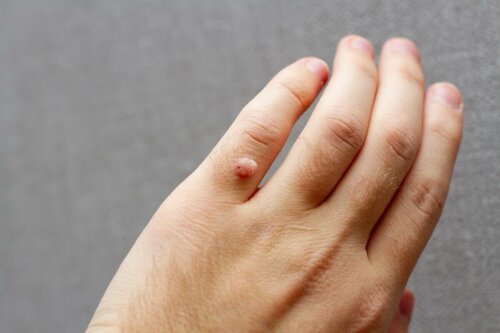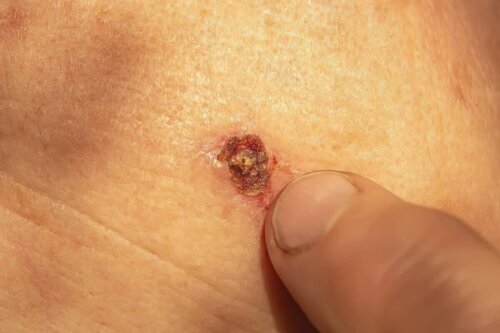Why Warts Bleed


Written and verified by the dermatologist Maria del Carmen Hernandez
Warts are skin lesions caused by the human papillomavirus. They’re often asymptomatic and usually only tend to cause aesthetic problems. However, sometimes, warts bleed or trigger some kind of pain.
Although this is rare, experts tend to recommend seeking treatment to speed up the recovery process. Since they affect several layers of the skin, they can be difficult to remove. In addition, they’re contagious and can spread to various body parts.
Symptoms of warts
Rough-textured bumps are the main symptom of warts. Beyond this, they don’t usually cause any discomfort. Only in certain cases, clinical manifestations include the following:
- Itching
- Tightness or feeling of pressure
- Pain, especially those located on the sole of the foot
- Bleeding

Read on to learn more: Plantar Warts: Characteristics and Treatment
Causes of warts
The human papillomavirus (HPV), which has about 100 different types, causes warts. Each serotype determines the location of the lesion in the body; hands, face, neck, armpits, feet, genitals, etc. In many cases, they resolve on their own, without the need for treatment.
The virus is able to enter the skin through wounds. Once it does this, it causes extra and rapid cell growth. The outermost skin layer becomes hard and thick, thus causing the bump.
The American Academy of Dermatology affirms that it spreads through direct contact with the injury, or by sharing personal use articles, such as towels or razors.
Why warts bleed
Warts have their own blood supply. Thus, they bleed a lot if you try to eliminate them with inappropriate procedures. Specifically, they contain dermal papillae intertwined with vascular loops.
With the help of a dermatoscope, medical professionals can see tortuous capillaries that generate a red dotted pattern on macroscopy, characteristic of the lesion. Warts also have specialized nerve endings, which is why you feel pain when you handle them.
Types of warts
Not all warts are the same. They’re often classified according to the body part where they appear. Also, their characteristics and symptoms may vary. What are the most common?
Plantar warts
These warts are often mistaken for calluses. They’re bigger than most warts, since the sole of the foot must support the body’s entire weight. They don’t grow exophytically but inwards, when you’re walking or standing. In addition, they’re the most complicated to treat due to their location.
Vulgar warts
They’re usually located on the face, the back of the hands, or on the cheeks. They’re hard rough growths that are scaly to the touch. As a study in The Journal of The Egyptian Public Health Association states, it’s one of the most common wart variants in children, with a 49% prevalence.
Flat warts
These warts are small bumps. They don’t have pigments. Instead, they have the same coloration as the surrounding skin. In addition, they’re located on the face, with prevalence on the forehead, cheeks, hands, and forearms.
Genital warts
Some strains of the human papillomavirus (HPV) cause warts in the genital area, including the vagina, penis, and anus. In fact, this virus is the most common sexually transmitted disease (STD).
This article may interest you: How to Prevent and Treat Warts with your Diet
Risk factors
Some people are more likely to develop warts. In fact, as they’re caused by viruses, it’s convenient to evaluate a person’s immune system to make sure that it isn’t compromised. The risk factors include the following:
- People who handle or work with raw meat, for example in butcher’s shops or slaughterhouses.
- Children or teens who use public showers after playing sports or in swimming pools.
- People who have a relative with warts.
- Suffering from immunodeficiencies. Recipients of organ transplants or diseases such as AIDS.
- People with atopic diseases.

Treatment options for warts
If warts bleed, you need to intervene as soon as possible to avoid complications. In fact, even if they don’t bleed, some prefer to remove them as they’re bothered by their unsightly appearance. Here are some of the procedures that can prove helpful:
- Cryosurgery. The use of liquid nitrogen or solid carbon dioxide (also called dry ice) to freeze the tissues. Although this procedure causes mild pain, it’s one of the most effective to remove warts. A dermatologist, in several sessions, once a week, should perform it.
- Topical medication. Special acid-based formulations that slowly burn the wart. You have to apply the product every day, which can cause slight skin irritation.
- Electrocoagulation. It often leaves scars.
- Surgical removal. It isn’t very popular due to its low effectiveness and the risk of viral dissemination. It has a high percentage of relapse.
- Laser. Although it’s effective, it’s slightly painful and can leave scars.
How to act if warts bleed
When warts bleed, it’s best to see a dermatologist for proper treatment. Trying to fix it at home can lead to complications and skin damage. In short, without timely intervention, it’s difficult to get rid of this highly contagious problem.
All cited sources were thoroughly reviewed by our team to ensure their quality, reliability, currency, and validity. The bibliography of this article was considered reliable and of academic or scientific accuracy.
- Al Aboud AM, Nigam PK. Wart (Plantar, Verruca Vulgaris, Verrucae) [Updated 2020 Jun 29]. In: StatPearls [Internet]. Treasure Island (FL): StatPearls Publishing; 2020 Jan
- InformedHealth.org [Internet]. Cologne, Germany: Institute for Quality and Efficiency in Health Care (IQWiG); 2006-. Warts: Overview. [Updated 2019 Nov 7]
- Liu J, Li H, Yang F, et al. Epidemiology and Clinical Profile of Cutaneous Warts in Chinese College Students: A Cross-Sectional and Follow-Up Study. Sci Rep. 2018;8(1):15450. Published 2018 Oct 18. doi:10.1038/s41598-018-33511-x
- Essa N, Saleh MA, Mostafa RM, Taha EA, Ismail TA. Prevalence and factors associated with warts in primary school children in Tema District, Sohag Governorate, Egypt. J Egypt Public Health Assoc. 2019;94(1):6. doi:10.1186/s42506-018-0007-0
This text is provided for informational purposes only and does not replace consultation with a professional. If in doubt, consult your specialist.








